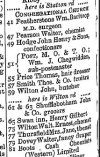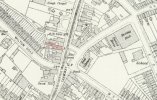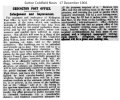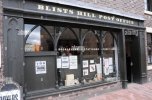-
Welcome to this forum . We are a worldwide group with a common interest in Birmingham and its history. While here, please follow a few simple rules. We ask that you respect other members, thank those who have helped you and please keep your contributions on-topic with the thread.
We do hope you enjoy your visit. BHF Admin Team
You are using an out of date browser. It may not display this or other websites correctly.
You should upgrade or use an alternative browser.
You should upgrade or use an alternative browser.
Erdington postmen heroes remembered
- Thread starter Astoness
- Start date
There was another Post Office not sure if the article is siggesting it was somewhere at the top of Mason Road, near where the workhouse was sited (now the library). But it certainly makes it clear tbis post 9ffice was on the same side of tge road. Midland Bank also mentioned (now HSBC) is still there. This article definitely suggests this side of High Street, not the side we've so far been looking at. Maybe it was temporarily on this side of the road until it moved to Sutton New Road ?
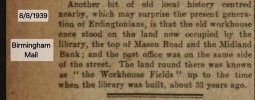
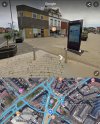
Source: British Newspaper Archive


Source: British Newspaper Archive
Last edited:
And for info, there's a PO (closer to Six Ways) mentioned in High Street on the thread link below. (This might, in fact, be the same PO as mentioned in post #545 as it would be that same side of the road).
This one was a combined post office and lending library service. In a nutshell, what I'm saying is we may have the wrong PO where the WW1 victims had been employed. Worth exploring I think.
This one was a combined post office and lending library service. In a nutshell, what I'm saying is we may have the wrong PO where the WW1 victims had been employed. Worth exploring I think.
Viv
It would have been a circulating library for which people paid to borrow books. I can remember them in boot and WH Smiths in the 1950s. They were often associated with booksellers or similar. This is almost certainly associated with a stationers (which is similar). The 1904 Kellys lists no 252 High st Erdington (see name when looking closely at photo), as John Barrett ,grocer, near the end of the street and 6 shops away from the Baptist chapel (which would be on the far right.) No 246 is Alfred Rodway, Tailor (Rodway in photo) and two doors up from there (where Library sign is) is...
It would have been a circulating library for which people paid to borrow books. I can remember them in boot and WH Smiths in the 1950s. They were often associated with booksellers or similar. This is almost certainly associated with a stationers (which is similar). The 1904 Kellys lists no 252 High st Erdington (see name when looking closely at photo), as John Barrett ,grocer, near the end of the street and 6 shops away from the Baptist chapel (which would be on the far right.) No 246 is Alfred Rodway, Tailor (Rodway in photo) and two doors up from there (where Library sign is) is...
Last edited:
Further info (mostly from the Warwickshire Herald or Harborne Herald) that I've come across about the Erdington Post Office, which could help to confirm/eliminate possible locations:
Mr S Taylor ran the Post Office in Erdington in the 1880s/90s. He was very active in Erdington, serving on various local civic committees.
The Post Office was situated two doors away from Mr W Pearson, the Chemist, in 1899.
In 1897, a watchmaker and silversmith named B. Runge had premises next door to the Post Office, Erdington
In 1889 and 1890, Erdington Post Office also had a lending library
In 1866, Mr E Sprawson, military haircutter, had premises located opposite the Post Office in Erdington.
Mr S Taylor ran the Post Office in Erdington in the 1880s/90s. He was very active in Erdington, serving on various local civic committees.
The Post Office was situated two doors away from Mr W Pearson, the Chemist, in 1899.
In 1897, a watchmaker and silversmith named B. Runge had premises next door to the Post Office, Erdington
In 1889 and 1890, Erdington Post Office also had a lending library
In 1866, Mr E Sprawson, military haircutter, had premises located opposite the Post Office in Erdington.
Last edited:
it could have been jan... looking at mikes map the building seemed to go back quite a way..maybe a counter post office at the front and sorting office at the back...only a guess thoughIsn't it more likely the postmen were based at the sorting office. So my question is - was that building the sorting office as well?
lyn
Was there a separate sorting office in Erdington? There were buildings on the map behind frontage which could have been used for an initial sorting of local mail, before transport to Central Birmingham. I have seen no sorting office in the area , At this time it was relatively rural compared to the 1930s, and that expansion presumably prompted the building of the much larger structure in the 1930s
thats what i was wondering in my last post mike...possible the back was used as a sorting office..all guess work thoughWas there a separate sorting office in Erdington? There were buildings on the map behind frontage which could have been used for an initial sorting of local mail, before transport to Central Birmingham. I have seen no sorting office in the area , At this time it was relatively rural compared to the 1930s, and that expansion presumably prompted the building of the much larger structure in the 1930s
lyn
looking at mikes map the old swan pub was on the corner at wilton road and the post office 5 buildings down opposite the green..looking at todays view the new swan pub is in the same place with wilton road on the left so the post office would have been where the grey borshcn building is...i think

Was trying see if I could find out how centralised sorting was at the turn of the century, Was not successful, but did discover that in 1903 deliveries in Birmingham started at 7.00am and finished at 6.30 pm . In that period there were 6 deliveries each day!
Don't know if this helps as I don't know how the PO structure worked, but Erdington was a Sub-Post Office. So would the High Street PO on Erdington Green have actually had a sorting office before the Sutton New Road PO was built ? Or would sorting of mail have been carried out elsewhere?
Found this in a search:
In the 1900s .........sub-post offices handled the distribution and collection of mail from their local area. Mail was then sent to larger sorting offices for distribution.
Found this in a search:
- Sub-Post Offices:
These smaller offices, often part of a shop or other business, primarily offered services like selling stamps, receiving and delivering mail, and offering financial services. They were not equipped for sorting mail in the same way as HPOs.
In the 1900s .........sub-post offices handled the distribution and collection of mail from their local area. Mail was then sent to larger sorting offices for distribution.
Last edited:
pjmburns
master brummie
I have emailed the Postal Museum to see if they can shed any light on where it was originally.
They do have the original plaque listed in their catalogue.
I have had one reply suggesting they don't seem to have that information but asking a couple of questions.
I have answered them and am awaiting a response.
They do have the original plaque listed in their catalogue.
I have had one reply suggesting they don't seem to have that information but asking a couple of questions.
I have answered them and am awaiting a response.
I wondered if it's a little difficult to find information about this post office because, as it was a sub post office, its sub postmaster wouldn't have been employed by the Post Office. The main business would most likely have been a shop, which offered Post Office services.
Last edited:
Viv
I think , though am not certain, that the system was a bit different then, The Erdington office is described as a branch office.. M.J.Daunton's book "Royal Mail, the Post Office since 1840"" states, in describing how employees were promoted states "The third avenue of promotion was to secure appointment as a subpostmaster or postmaster", which would mean they were employees. The entry for no 51 High St do not list any other purpose other than a post office, unlike later establishments which were also shops
I think , though am not certain, that the system was a bit different then, The Erdington office is described as a branch office.. M.J.Daunton's book "Royal Mail, the Post Office since 1840"" states, in describing how employees were promoted states "The third avenue of promotion was to secure appointment as a subpostmaster or postmaster", which would mean they were employees. The entry for no 51 High St do not list any other purpose other than a post office, unlike later establishments which were also shops
Brasscaster
master brummie
The attached newspaper article from December 1904 describes improvements to Erdington Post Office. It confirms its position near the village green and also confirms there was an old sorting room at the rear of the premises. The second cutting reveals that the postmaster was William John Chegwidden who had worked in the Birmingham chief office for about 14 years before moving to Erdington where he spent another 14 years before being promoted to the position of Postmaster of Chesham, Buckinghamshire in 1915.
Attachments
That's great Brasscaster. Lots of detail in those clippings, just what we need. I was beginning to think we'd never get any detail about the PO. Always worth persisting with searches.
Last edited:
pjmburns
master brummie
I have had another reply from the Postal Museum.
However, in spite of using words like "original" and "stone not wooden" all they are able to tell me is where the wooden plaque is now. I also get referred to online directories and newspaper archives - both of which we have used extensively. finally Birmingham Archives - but I have checked their online catalogue to no avail. So basically I don't think the Museum knows.
I have made one more attempt to get them to understand what we want to know;
Thanks but I already know that and that is a wooden replica of the original stone plaque.
What we are trying to find out is where it was sited when unveiled in 1922.
My understanding is that Sutton New Road wasn't built until later.
I am asking about the original stone plaque which was found in a skip and which Birmingham History Forum helped get placed at the Memorial Arboretum.
Further research has now shown us the Post Office in 1922 was at 51 High Street (we believe vacated when Sutton New Road was built).
The questions are: was it at the High Street building? Was it inside or out?
Not hopeful. Might need to wait for Erdington papers 1922 to come online.
However, in spite of using words like "original" and "stone not wooden" all they are able to tell me is where the wooden plaque is now. I also get referred to online directories and newspaper archives - both of which we have used extensively. finally Birmingham Archives - but I have checked their online catalogue to no avail. So basically I don't think the Museum knows.
I have made one more attempt to get them to understand what we want to know;
Thanks but I already know that and that is a wooden replica of the original stone plaque.
What we are trying to find out is where it was sited when unveiled in 1922.
My understanding is that Sutton New Road wasn't built until later.
I am asking about the original stone plaque which was found in a skip and which Birmingham History Forum helped get placed at the Memorial Arboretum.
Further research has now shown us the Post Office in 1922 was at 51 High Street (we believe vacated when Sutton New Road was built).
The questions are: was it at the High Street building? Was it inside or out?
Not hopeful. Might need to wait for Erdington papers 1922 to come online.
Still very odd that the tablet. should turn up in Ladywood in the 1970s. It does suggest it was possibly moved (when the Erdington High Street PO was demolished, 1930s ?) then somehow 'lost' ot forgotten perhaps. Wonder if the wooden one was made because they couldn't add any more names (for WW2 deaths) to the earlier stone/marble tablet.
Last edited:
pjmburns
master brummie
I wondered if the wooden one was made because the other was missing. Or they had a temporary wooden one immediately after WW1 until they could get the stone one engraved. Stone masons must have been incredibly busy at that time.
I wondered if the postmaster took it when High Street closed. Perhaps he moved to Ladywood but when I looked Ladywood had a lady postmistress. Maybe we can see where he went to.
I wondered if the postmaster took it when High Street closed. Perhaps he moved to Ladywood but when I looked Ladywood had a lady postmistress. Maybe we can see where he went to.
In the last Heritage Week I visited the Birmingham People's History Archive, which is housed at the Midland Institute. I seem to remember that they might hold the archives of the Birmingham Postal Workers Union (though I may be wrong). Speaking to the BMI today , they said people are usually there on Tuesday, Wednesday and Thursday.
pjmburns
master brummie
Lyn and I have been studying this photo and have both come to the same conclusion.i also believe that this photo shows the plaque on the wall of the old post office in the high st erdington which we know is where it was originally placed
lyn
View attachment 201439
That mark on the wall high up is unlikely to be a memorial as it is too high to be easily seen or read. It would have been tricky to have been unveiled and blessed by Canon Swindell.
However, close examination shows a strange patch of brickwork under the window by the door. We are now wondering if this was the site of the plaque - low down, easily seen and read.
Possibly removed when the PO closed. Not sure if went to the new building then or went with the Postmaster and then got mislaid or what happened.
Any thoughts on this positioning?
I'm not sure I've ever seen one placed in a position like that. But I guess it's possible.
Having said that, weren't outdoor memorial tablets usually made of stone ? Is this more like marble on closer inspection ? Common in church interior memorials or other public interior memorials.
Having said that, weren't outdoor memorial tablets usually made of stone ? Is this more like marble on closer inspection ? Common in church interior memorials or other public interior memorials.
Last edited:

